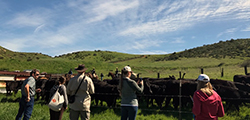For some public properties, livestock grazing can be an important land management tool to help maintain specific habitat conditions, control invasive weeds and reduce fire hazards. In areas invaded by non-native vegetative species, it is necessary to control vegetation height and density in order to keep habitats functioning for certain sensitive species. For instance, the burrowing owl requires low vegetation cover in order to forage for prey effectively and prevent predators from approaching unseen. Other species that have been known to benefit from managed livestock grazing include California tiger salamander, Yosemite toad and certain sensitive butterfly species.
Controlling the height and density of non-native annual grasslands through grazing has also been shown to help increase forage efficiency for many species of raptors, and it’s used as a tool in some areas of California to maintain sensitive vernal pool habitats.
For years, local, state and federal agencies, as well as non-government organizations, have utilized livestock grazing on public lands. It is important to have many tools available for habitat management because it can sometimes be complicated. Factors such as the presence of listed or protected species, compatible public land uses and erosion -- as well as other land management practices such as herbicide application, mowing and prescribed fires -- must all be considered.

CDFW’s Rancho Jamul Ecological Reserve in San Diego County recently hosted a livestock grazing workshop presented by Rancher to Rancher (R2R) program spokesperson Kent Reeves, and UC Davis researcher Dr. Christina Wolf. The goal of the R2R program is to provide information and educational resources to private ranchers about evolving livestock management practices intended to promote native ecosystem health, and therefore, more sustainable grazing programs. More than 40 participants, including local private ranchers and representatives from about a dozen government and non-government organizations attended the workshop. Participants learned about developing progressive management practices, such as the use of increased stocking densities for shorter, more frequent durations, in order to increase carbon sequestration in the soils. This method is currently being studied as a way of encouraging native grass species as well as combating changing climate conditions.
Cow photo by CDFW Environmental Scientist Marcia Grefsrud